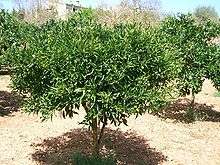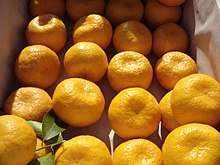Citrus × deliciosa
Citrus × deliciosa (thorny (Australia), amarillo, beladi, Willowleaf Mandarin, Mediterranean Mandarin[1]) is a citrus hybrid mandarin orange with just under 6 % pumelo ancestry.[2] It is related to the ponkan.[3][4]
| Citrus × deliciosa | |
|---|---|
 | |
| Hybrid parentage | Parents unknown; mandarin orange with some pomelo ancestry |
| Cultivar | "Mediterranean"? |
| Marketing names | Willowleaf, Ba Ahmed (Morocco), Blida, Boufarik and Bougie (Algeria), Bodrum (Turkey), Paterno and Palermo (Italy), Nice and Provence (France), Valencia (Spain), Setubalense (Portugal); commune (French), comuna (Spanish), gallego (Portuguese), koina (Greek), yerli (Turkish), and beladi (various spellings, Arabic); Effendi or Yousef Effendi (Egypt and the Near East), Emperor, Avana or Speciale (Italy), Thorny (Australia), Mexerica or Bergamota (Brazil), Montegrina, Natal, and Chino or Amarillo (Mexico).[1] |
| Origin | Italy |
It has been widely grown around the Mediterranean since it appeared in Italy (between 1810 and 1818), but was not found in the orient until it was exported there.[1] It is one of the most commercially important citrus. Its sweet fruit is eaten, its rind oil is used to flavour food and drinks, and petitgrain oil is extracted from the pruned leaves[1]. Flower (particularly petals) are also rich in essential oils[5].
This species produce those which are perhaps the tastiest of all citrus fruits. That's why, its scientific name is Citrus × deliciosa, which means, delicious citrus[6].
The production of Mediterranean mandarin has suffered a sharp decline since the middle of the 20th century because of the perishability of the fruits and the tendency for an alternating production with years of low production and years of excessive tree load, but consumers who require more intense citrus aromas and fragrances continue to enjoy this mandarin[6][7]. Therefore, this mandarin has a commercial space for different markets that value the traditional cultivars[7]. This is the case of the PGI "Citrinos do Algarve"[8]. These characteristics and its time of maturity, which implies being little affected by Ceratitis capitata, make Mediterranean mandarin recommended for organic farming[7].
References
- http://citruspages.free.fr/mandarins.html#deliciosa
- Wu, Guohong Albert; Terol, Javier; Ibanez, Victoria; López-García, Antonio; Pérez-Román, Estela; Borredá, Carles; Domingo, Concha; Tadeo, Francisco R; Carbonell-Caballero, Jose; Alonso, Roberto; Curk, Franck; Du, Dongliang; Ollitrault, Patrick; Roose, Mikeal L. Roose; Dopazo, Joaquin; Gmitter Jr, Frederick G.; Rokhsar, Daniel; Talon, Manuel (2018). "Genomics of the origin and evolution of Citrus". Nature. 554 (7692): 311–316. doi:10.1038/nature25447. PMID 29414943. and Supplement
- Wu GA, et al. (2014). "Sequencing of diverse mandarin, pummelo and orange genomes reveals complex history of admixture during citrus domestication". Nature Biotechnology. 32 (7): 656–662. doi:10.1038/nbt.2906. PMC 4113729. PMID 24908277.
- Barkley NA, Roose ML, Krueger RR, Federici CT (2006). "Assessing genetic diversity and population structure in a citrus germplasm collection utilizing simple sequence repeat markers (SSRs)". Theoretical and Applied Genetics. 112 (8): 1519–1531. doi:10.1007/s00122-006-0255-9. PMID 16699791.
- Silva, Luis Rodrigues da; Silva, Branca (2016). "Bioactive Compounds of Citrus as Health Promoters". Natural Bioactive Compounds from Fruits and Vegetables as Health Promoters Part I. pp. 29–97. doi:10.2174/9781681082394116010005. ISBN 9781681082394.
- Duarte, Amílcar; Fernandes, Jacinta; Bernardes, João; Miguel, Graça (2016). "Citrus as a Component of the Mediterranean Diet". J. Spat. Org. Dyn. IV (4): 289–304.
- Pacheco, Pedro; Duarte, Amílcar (2016). "Caracterização da rebentação da tangerineira 'Setubalense' em anos de safra e de contrassafra". Actas Portuguesas de Horticultura. 25: 43–49.
- "Portuguese Traditional Products".
